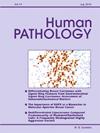疫苗样水疱性淋巴增生性疾病的临床病理和遗传分析
IF 2.7
2区 医学
Q2 PATHOLOGY
引用次数: 0
摘要
疫苗样水疱性淋巴细胞增生性疾病(HV-LPD)是一种罕见的eb病毒(EBV)相关疾病,其系统性形式有进展倾向,一些病例最终可能发展为类似NK/ t细胞淋巴瘤甚至侵袭性NK细胞白血病的疾病。我们报告了12例中位年龄15.8岁的系统性HV-LPD患者,其皮肤病累及面部、躯干、四肢和浆膜。12例患者中有10例(83%)出现全身性症状,其中9例面部水肿突出,2例骨髓受累。所有病例均呈EBER和CD3阳性,缺乏CD20。其他阳性标志物包括12例中有11例CD8(91.6%), 12例中有1例CD56(8.3%), 7例中有6例颗粒酶B(85.7%), 2例中有2例TIA1(100%), 3例中有1例CD30(33.3%)。其中2例显示单克隆TCR-γ, 1例也有TCR-β重排。对5例患者进行测序,发现ALMS1、ALPK2、BCORL1、kk2、KMT2D、NCOR1、PTPRD、RHOA、TNIK、TP53、ZFHX3反复突变,单例患者出现BCOR、CREBBP、DDX3X、DMXL2、IRF4、IRF8、KDM6A、MGA、NCOR2、PLCG1、PRDM1、RNF213、SMARCA4、STAT5B、TET2突变等多种突变。大多数患者接受免疫调节治疗,2例接受甲氨蝶呤治疗,3例接受多药化疗,1例接受造血干细胞移植。对10例患者进行随访,其中6例死于疾病,1例无疾病存活。我们的研究结果显示,持续性/进行性全身性HV-LPD患者预后较差,对化疗反应不佳。突变谱与结外NK/T淋巴瘤有一定的相似之处,但也有显著差异。本文章由计算机程序翻译,如有差异,请以英文原文为准。
Hydroa vacciniforme lymphoproliferative disorder, a clinicopathologic and genetic analysis
Hydroa vacciniforme lymphoproliferative disorder (HV-LPD) is a rare Epstein–Barr virus (EBV)-associated disease and the systemic form shows a propensity to progress and some cases may eventually develop a disease simulating NK/T-cell lymphoma or even aggressive NK-cell leukemia. We report 12 patients with systemic HV-LPD of median age 15.8 years with dermatosis involving the face, trunk, extremities and serous membranes. Ten of 12 patients (83 %) had systemic symptoms including 9 with prominent facial edema and 2 with bone marrow involvement. All cases were positive for EBER and CD3 and lacked CD20. Additional positive markers included CD8 in 11 of 12 (91.6 %), CD56 in 1 of 12 (8.3 %), granzyme B in 6 of 7 (85.7 %), TIA1 in 2 of 2 (100 %) and CD30 in 1 of 3 (33.3 %). Two cases studied demonstrated monoclonal TCR-γ and one also had TCR-β rearrangements. Five cases were sequenced and showed recurrent mutations in ALMS1, ALPK2, BCORL1, KANK2, KMT2D, NCOR1, PTPRD, RHOA, TNIK, TP53 and ZFHX3, and single cases showed a variety of mutations including BCOR, CREBBP, DDX3X, DMXL2, IRF4, IRF8, KDM6A, MGA, NCOR2, PLCG1, PRDM1, RNF213, SMARCA4, STAT5B and TET2 mutation. Most patients were treated with immunomodulating therapy, two received methotrexate, three received multiagent chemotherapy and one underwent hematopoietic stem cell transplant. Follow-up was available in 10 patients of whom 6 died of disease and one was alive without disease. Our results showed that patients with persistent/progressive systemic HV-LPD have a poor prognosis and did not respond well to chemotherapy. The mutation spectrum bore some resemblance to extranodal NK/T lymphomas but also had notable differences.
求助全文
通过发布文献求助,成功后即可免费获取论文全文。
去求助
来源期刊

Human pathology
医学-病理学
CiteScore
5.30
自引率
6.10%
发文量
206
审稿时长
21 days
期刊介绍:
Human Pathology is designed to bring information of clinicopathologic significance to human disease to the laboratory and clinical physician. It presents information drawn from morphologic and clinical laboratory studies with direct relevance to the understanding of human diseases. Papers published concern morphologic and clinicopathologic observations, reviews of diseases, analyses of problems in pathology, significant collections of case material and advances in concepts or techniques of value in the analysis and diagnosis of disease. Theoretical and experimental pathology and molecular biology pertinent to human disease are included. This critical journal is well illustrated with exceptional reproductions of photomicrographs and microscopic anatomy.
 求助内容:
求助内容: 应助结果提醒方式:
应助结果提醒方式:


